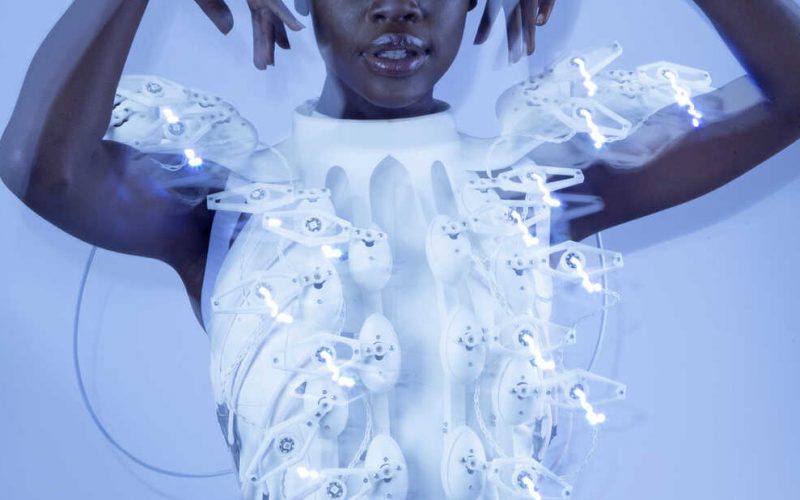The fashion industry, long dictated by seasonal trends and creative intuition, is undergoing a profound and data-driven transformation. At the heart of this revolution is Artificial Intelligence, an invisible thread weaving itself into every facet of the industry—from the initial spark of a design concept to the interactive garments we wear on our bodies. As the global footwear market alone marches toward a projected valuation of over $1 trillion by 2031, it’s clear that technology is no longer an accessory but the very fabric of modern fashion. This convergence is giving rise to a new category of products and experiences, where apparel is not just worn, but interacted with. This shift is a major focus in AI in Fashion / Wearable Tech News, signaling a move from passive consumption to active engagement, powered by sophisticated sensors, machine learning algorithms, and seamless connectivity.
We are entering an era where our clothes and shoes are becoming intelligent companions. They can coach our athletic performance, monitor our health, adapt to our environment, and even grant us access to burgeoning digital worlds like the metaverse. This article explores the comprehensive technical landscape of AI in fashion and wearables, dissecting the key technologies, real-world applications, and the vast implications for consumers and creators alike. We will unravel how AI is not just changing what we wear, but fundamentally redefining our relationship with our wardrobe.
The New Fabric of Fashion: AI’s Role from Design to Digital Twin
Artificial intelligence is making its mark long before a garment ever reaches a production line or a digital storefront. Its influence spans the entire value chain, introducing unprecedented levels of efficiency, creativity, and personalization. This holistic integration is reshaping industry standards and creating new avenues for innovation.
Generative AI and Algorithmic Couture
The creative process, once considered the exclusive domain of human designers, is now a collaborative effort with AI. Generative AI models, trained on vast datasets of images, patterns, and historical fashion trends, are capable of producing novel design concepts in seconds. Tools like Stable Diffusion and Midjourney are being used by designers to rapidly prototype ideas, explore unconventional aesthetics, and break creative blocks. Beyond mere inspiration, specialized platforms are emerging that allow brands to input specific parameters—such as target demographic, material constraints, and desired color palettes—to generate entire collections. This trend is a hot topic in AI Tools for Creators News, as it empowers designers to focus on curation and refinement rather than starting from a blank slate. The result is a fusion of human artistry and machine-generated possibility, leading to what some are calling “algorithmic couture.”
Hyper-Personalization and Predictive Analytics
AI’s analytical prowess is revolutionizing retail and supply chain management. By analyzing customer data—browsing history, purchase patterns, social media engagement, and even data from wearable devices—AI algorithms can create highly personalized shopping experiences. Recommendation engines suggest products with uncanny accuracy, while virtual try-on solutions powered by AR/VR AI Gadgets News and computer vision allow customers to see how an outfit looks without ever stepping into a fitting room. On the back end, this same data fuels predictive models that forecast demand for specific styles, sizes, and colors with remarkable precision. This allows brands to optimize inventory, reduce overproduction and waste, and move closer to a sustainable, on-demand manufacturing model, a significant development tracked in Smart City / Infrastructure AI Gadgets News for its impact on logistics and resource management.
Digital Fashion and the Metaverse Wardrobe
The line between our physical and digital identities is blurring, and fashion is at the forefront of this convergence. AI is instrumental in the creation of digital garments—hyper-realistic, purely virtual clothing designed for avatars in games, social platforms, and the metaverse. Creating these assets requires sophisticated 3D modeling and AI-powered texturing tools that can simulate the physics of fabric in a virtual environment. This burgeoning market allows for limitless self-expression without physical constraints and is a major point of discussion in AI in Gaming Gadgets News. Brands are launching virtual-only collections and collaborating with gaming platforms, establishing a new, highly profitable revenue stream where AI is the master tailor for our digital twins.
Smart Footwear: More Than Just a Step Counter

Perhaps the most tangible and advanced application of AI in fashion today is within smart footwear. These are not simply shoes with a pedometer; they are sophisticated data-collection platforms packed with sensors and powered by intelligent algorithms. They represent a paradigm shift, turning a passive piece of apparel into an active coach, diagnostic tool, and performance enhancer.
The Sensor-Infused Sole: The Hardware Core
The intelligence of a smart shoe begins in its sole, which is embedded with a suite of micro-electromechanical systems (MEMS). The core of this system is often an Inertial Measurement Unit (IMU), which typically includes:
- Accelerometers: These measure linear acceleration in three axes, detecting motion, impact forces upon landing, and step frequency.
- Gyroscopes: These measure angular velocity, tracking the rotation and orientation of the foot through each phase of a stride, such as pronation and supination.
- Magnetometers: Used in conjunction with the other sensors, they provide a sense of absolute direction, like a compass.
Beyond the IMU, many advanced models incorporate an array of pressure sensors distributed across the insole. These sensors create a dynamic map of how weight is distributed across the foot, identifying imbalances and high-pressure zones. This granular data is a goldmine for performance and health analysis, a key area covered by AI Sensors & IoT News. All this hardware is managed by a low-power microcontroller, a prime example of an edge computing application that is a frequent topic in AI Edge Devices News.
From Raw Data to Actionable Insights: The AI Engine
The torrent of raw data from these sensors is meaningless without AI to interpret it. This is where machine learning algorithms come into play. Data is streamed from the shoe via Bluetooth to a companion app on a mobile device, where cloud-based or on-device AI models get to work. These models are trained on massive datasets of movement patterns from thousands of athletes. They perform several key tasks:
- Activity Recognition: The AI can accurately classify activities—differentiating between walking, jogging, sprinting, jumping, and even specific sports movements.
- Gait Analysis: By analyzing the combined sensor data, the AI builds a detailed profile of a user’s running or walking gait. It calculates metrics like stride length, cadence, ground contact time, foot-strike pattern (heel, midfoot, or forefoot), and vertical oscillation.
- Performance Coaching & Injury Prevention: This is the ultimate value proposition. The AI compares the user’s personal data against optimal biomechanical models. If it detects an issue—such as excessive pronation that could lead to knee pain or an imbalanced foot strike that reduces efficiency—it provides real-time audio feedback or post-workout reports with corrective drills. This application is a leading story in AI Fitness Devices News and Health & BioAI Gadgets News.
Case Study: Under Armour’s HOVR Connected Running Shoes
A prime real-world example is Under Armour’s HOVR line. A sensor embedded in the midsole of the right shoe tracks detailed running data without needing a phone present during the run. Once synced with the MapMyRun app, the AI analyzes the data to provide personalized coaching on form. For instance, it might tell a runner their cadence is too low for their pace, which can lead to overstriding and higher impact forces. It then suggests focusing on taking shorter, quicker steps to improve efficiency and reduce injury risk. This closed feedback loop—run, analyze, coach, improve—is the hallmark of effective AI-driven wearable technology.
Beyond the Shoe: The Expanding Universe of AI Wearables
While footwear is a leading category, the principles of embedding intelligence into apparel are being applied across the entire wardrobe. From smart shirts that act as continuous health monitors to augmented reality glasses that overlay digital information onto our world, AI is creating a new ecosystem of interconnected, intelligent clothing.
Intelligent Apparel and Smart Textiles
The next frontier is weaving technology directly into the threads of our clothes. Smart textiles incorporate conductive fibers and miniaturized sensors to create garments that are indistinguishable from normal clothing but possess powerful monitoring capabilities. Companies are developing biometric shirts that can track electrocardiogram (ECG) data, respiration rate, and body temperature. This transforms clothing into a non-invasive medical device, a development closely watched in AI Monitoring Devices News. For wellness, this technology is also being applied to sleepwear that analyzes sleep quality, a trend highlighted in AI Sleep / Wellness Gadgets News. The AI component analyzes these continuous data streams to detect anomalies, predict health issues, or optimize athletic recovery.

The Augmented Self: Smart Glasses and AI Companions
Eyewear is evolving from a tool for vision correction into a high-tech interface for AI. The latest developments in Smart Glasses News showcase devices like the Ray-Ban Meta Smart Glasses, which integrate cameras and AI to identify objects, translate languages in real-time, and provide hands-free access to an AI Assistant. This technology merges our physical and digital perception, with AI acting as a co-pilot for our daily lives. As these devices become more powerful, they will offer seamless AR overlays for navigation, shopping, and social interaction, representing a convergence of AI-enabled Cameras & Vision News and AI Phone & Mobile Devices News.
The Ethical Thread: Data Privacy and Security
The rise of intelligent wearables brings a critical challenge: data privacy. These devices collect some of the most intimate data imaginable—our location, our activity levels, and even our biometric signals. This raises important questions. Who owns this data? How is it being used and protected? A data breach involving this level of personal information could have severe consequences. As such, robust security is paramount, a concern that is a recurring theme in AI Security Gadgets News. Brands in this space must prioritize transparency, user control over data, and strong encryption to build and maintain consumer trust. The potential for data misuse or surveillance is a significant pitfall that the industry must navigate carefully.
Recommendations and Future Outlook
As the world of AI-powered fashion and wearables continues to expand, both consumers and creators need to approach it with a strategic mindset. The technology holds immense promise, but its successful implementation depends on thoughtful design and informed choices.

Tips for Consumers and Brands
For consumers looking to invest in a smart garment or wearable, it’s essential to look beyond the marketing hype. Key considerations should include the accuracy of the sensors, the intuitiveness of the companion app, battery life, and, most importantly, the company’s privacy policy. Look for brands that are transparent about how your data is used and give you granular control.
For brands and developers, the focus must be on creating genuine value. The biggest pitfall is “tech for tech’s sake.” A successful AI wearable solves a real problem or enhances an experience in a meaningful way. Best practices include focusing on a seamless user experience, ensuring the technology is unobtrusive, and building a robust ecosystem around the product that fosters community and provides ongoing value. The future of this market, a key topic for AI Research / Prototypes News, will be won by those who master the integration of hardware, software, and human-centered design.
The Next Frontier: What’s on the Horizon?
The future of AI in fashion is even more integrated and autonomous. We can anticipate closed-loop systems where clothing actively responds to biometric data—for example, a jacket that adjusts its ventilation based on your body temperature or a compression suit that provides haptic feedback to correct your posture during a workout. The development of Neural Interfaces News suggests a distant future where we might control our digital experiences or even adaptive clothing with our thoughts. Furthermore, advancements in robotics and AI will lead to fully automated, on-demand manufacturing, where a generative AI designs a unique piece of clothing based on your preferences and a robotic system produces it locally, a vision that combines Robotics News with sustainable fashion.
Conclusion
The integration of Artificial Intelligence into fashion and wearable technology is not a fleeting trend; it is the dawn of a new era. We are moving from a world of static apparel to one of dynamic, intelligent systems that enhance our lives, monitor our health, and unlock new forms of self-expression. From the generative algorithms sketching the next season’s styles to the smart insoles coaching our every step, AI is the invisible force reshaping the industry. While challenges around data privacy and ethical implementation remain, the trajectory is clear. The wardrobe of the future will be connected, personalized, and predictive. The news and developments in AI in Fashion / Wearable Tech News will continue to chronicle this exciting evolution, as our clothing becomes less about what we wear and more about who we are and what we can achieve.










